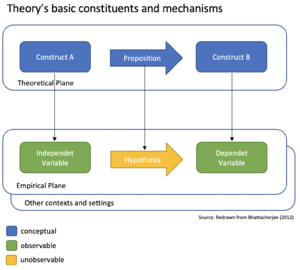Template:Operationalize Dependent Variable(s): Difference between revisions
(Created page with "== Operationalize Dependent Variable(s) == === Description === * Operationalization refers to the process of developing indicators or items for measuring these (abstract) cons...") |
|||
| (One intermediate revision by the same user not shown) | |||
| Line 1: | Line 1: | ||
== Operationalize Dependent Variable(s) == | == Operationalize Dependent Variable(s) == | ||
=== Description === | === Description === | ||
[[File:Theory’s basic constituents and mechanisms.png|thumb]] | |||
* Operationalization refers to the process of developing indicators or items for measuring these (abstract) constructs. | * Operationalization refers to the process of developing indicators or items for measuring these (abstract) constructs. | ||
* Operationalize through levels of measurement (= rating scales: refer to the values that an indicator can take). | * Operationalize through levels of measurement (= rating scales: refer to the values that an indicator can take). | ||
Levels of measurement: | Levels of measurement: | ||
* statistical properties of rating scales | |||
statistical properties of rating scales | |||
* nominal scale | * nominal scale | ||
* ordinal scale | * ordinal scale | ||
| Line 15: | Line 15: | ||
* semantic differential scale | * semantic differential scale | ||
* Guttman scale | * Guttman scale | ||
=== Examples === | === Examples === | ||
Latest revision as of 13:32, 20 March 2020
Operationalize Dependent Variable(s)
Description
- Operationalization refers to the process of developing indicators or items for measuring these (abstract) constructs.
- Operationalize through levels of measurement (= rating scales: refer to the values that an indicator can take).
Levels of measurement:
- statistical properties of rating scales
- nominal scale
- ordinal scale
- interval scale
- ratio scale
- binary scale
- Likert scale
- semantic differential scale
- Guttman scale
Examples
Further Readings
[1] Bhattacherjee, A. (2012). "Social Science Research: Principles, Methods, and Practices", Textbooks Collection. 3. Available at: https://scholarcommons.usf.edu/oa_textbooks/3
Create Research Design
Description
Survey:
collect self-reported data of people standardized questionnaire or interview
Simulation:
state a hypothesis imitate some real process or action to prove your hypothesis suitable for observing correlation between variables
Laboratory Experiment:
independent variables are manipulated by the researcher (as treatments) subjects are randomly assigned to treatment results of the treatments are observed
Field Experiment:
conducted in field settings, e.g. real organization rare, because of the difficulties associated with manipulating treatments and controlling for extraneous effects in a field setting
Examples
Further Readings
[1] Myers, M. D. (2009). “Qualitative Research in Business and Management”, SAGE Publications: Auckland, New Zealand.
[2] Bhattacherjee, A. (2012). "Social Science Research: Principles, Methods, and Practices", Textbooks Collection. 3.Available at: https://scholarcommons.usf.edu/oa_textbooks/3
